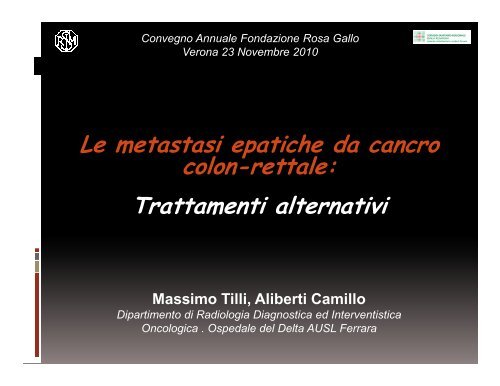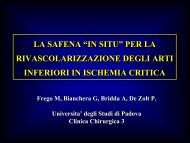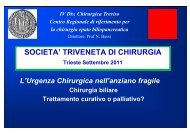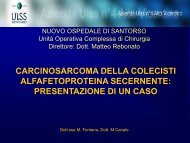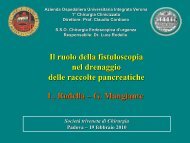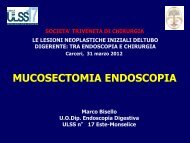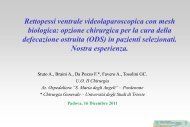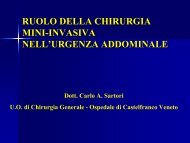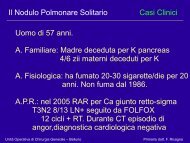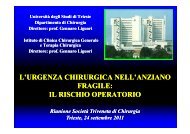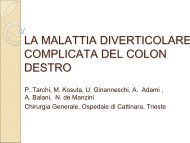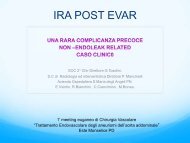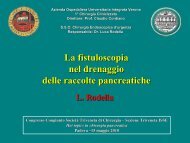Convegno Annuale Fondazione Rosa Gallo Verona 23 Novembre ...
Convegno Annuale Fondazione Rosa Gallo Verona 23 Novembre ...
Convegno Annuale Fondazione Rosa Gallo Verona 23 Novembre ...
You also want an ePaper? Increase the reach of your titles
YUMPU automatically turns print PDFs into web optimized ePapers that Google loves.
<strong>Convegno</strong> <strong>Annuale</strong> <strong>Fondazione</strong> <strong>Rosa</strong> <strong>Gallo</strong><strong>Verona</strong> <strong>23</strong> <strong>Novembre</strong> 2010Le metastasi epatiche da cancrocolon-rettale:Trattamenti alternativiMassimo Tilli, Aliberti CamilloDipartimento di Radiologia Diagnostica ed InterventisticaOncologica . Ospedale del Delta AUSL Ferrara
<strong>Convegno</strong> <strong>Annuale</strong> <strong>Fondazione</strong> <strong>Rosa</strong> <strong>Gallo</strong><strong>Verona</strong> <strong>23</strong> <strong>Novembre</strong> 2010• LM from CRC occur in more than50% of patients• Only a small mumber of patientswill be candidates for surgicalresection• 5-year survival after resection is25-35%• For not resectable LM survival rateis less than 5% at 5 years• Palliative chemotherapy is the mainstay of treatment
<strong>Convegno</strong> <strong>Annuale</strong> <strong>Fondazione</strong> <strong>Rosa</strong> <strong>Gallo</strong><strong>Verona</strong> <strong>23</strong> <strong>Novembre</strong> 2010•Toxicity is common and median survival isabout 18 months, although this had aslightly increase adding monoclonalantibodies and angiogenesis inhibitors (22months)• Ablative or trans-arterial techniquesallow localised, minimally invasive therapywithout systemic toxicity or morbidity• Catheter-delivered arterial treatmentsinclude TACE with eluting-beads
<strong>Convegno</strong> <strong>Annuale</strong> <strong>Fondazione</strong> <strong>Rosa</strong> <strong>Gallo</strong><strong>Verona</strong> <strong>23</strong> <strong>Novembre</strong> 2010SurgicalResectionTransplantationLocalRadiofrequency AblationTranscatheter Arterial Chemoembolisation(TACE)Transarterial EmbolisationCryoablationMicrowave AblationRadio-Embolisation (Yttrium-90)Hepatic Arterial Infusion PumpSystemicChemotherapyBest Supportive Care
<strong>Convegno</strong> <strong>Annuale</strong> <strong>Fondazione</strong> <strong>Rosa</strong> <strong>Gallo</strong><strong>Verona</strong> <strong>23</strong> <strong>Novembre</strong> 2010THERMAL ABLATION•Radiofrequency Ablation-Heat•Microwave -Heat•Cryoablation -Cold•Laser –Heat•High Frequency Ultrasound -Heat
<strong>Convegno</strong> <strong>Annuale</strong> <strong>Fondazione</strong> <strong>Rosa</strong> <strong>Gallo</strong><strong>Verona</strong> <strong>23</strong> <strong>Novembre</strong> 2010Radiofrequency Ablation (RFA)RF thermal ablation works by converting RF waves intoheat. A high-frequency alternating current (100-500kHz) passes from an uninsulated electrode tip into thesurrounding tissues and causes ionic vibration. The ionicvibration causes frictional heating of the tissuessurrounding the electrode. The goal of RFA is to achievelocal temperatures that make tissue destruction occur.
<strong>Convegno</strong> <strong>Annuale</strong> <strong>Fondazione</strong> <strong>Rosa</strong> <strong>Gallo</strong><strong>Verona</strong> <strong>23</strong> <strong>Novembre</strong> 2010Limited number of LM (1-4)Size 3cm more difficult•More likely to have multiple treatments•Changes in equipment over short period of time makesevaluation of data difficult
<strong>Convegno</strong> <strong>Annuale</strong> <strong>Fondazione</strong> <strong>Rosa</strong> <strong>Gallo</strong><strong>Verona</strong> <strong>23</strong> <strong>Novembre</strong> 2010Stanget al 2009 meta-analysis n=21 studies RFA site recurrence rate 9-42% (usually at therim) Median time to local tumorprogression 3.5-9 months Systemic disease progression(new hepatic and extrahepatic) 41-99% Median time to systemic progression 6-13 months Complications(major) 1.8-13% (0.9-7%)RFA is an useful adjunct to surgery and chemotherapy inunresectable CLMStang et al 2009 Eur Journal of Cancer –A meta analysis
<strong>Convegno</strong> <strong>Annuale</strong> <strong>Fondazione</strong> <strong>Rosa</strong> <strong>Gallo</strong><strong>Verona</strong> <strong>23</strong> <strong>Novembre</strong> 2010Selective Internal Radiation Therapy(SIRT)SIRT is a technique that allows high average doses ofradiation (200-300 Gy) to liver tumors with minimalserious effects on the non-tumorous liver. Thetreatment entails delivery of usually a single dose ofYttrium microspheres into the hepatic artery which, byvirtue of almost exclusive arterial supply to liver tumorscompared with the predominant portal supply to normalliver, results in selective tumor uptake and irradiation.
<strong>Convegno</strong> <strong>Annuale</strong> <strong>Fondazione</strong> <strong>Rosa</strong> <strong>Gallo</strong><strong>Verona</strong> <strong>23</strong> <strong>Novembre</strong> 2010 90Yttrium microspheres offers a relatively safemethod for halting the progression of HCC andmetastatic liver disease. This technique allows higher levels of radiationto be delivered selectively to the tumor,limiting dose to normal tissue. “Internal beam radiation” does not significantlydecrease the quality of life of the patient, andin most cases extends the survival time.More invasivetechnique ???Costs ?????Survival rate forLM ???Work in progress
<strong>Convegno</strong> <strong>Annuale</strong> <strong>Fondazione</strong> <strong>Rosa</strong> <strong>Gallo</strong><strong>Verona</strong> <strong>23</strong> <strong>Novembre</strong> 2010LOCOREGIONAL CHEMOTHERAPY
<strong>Convegno</strong> <strong>Annuale</strong> <strong>Fondazione</strong> <strong>Rosa</strong> <strong>Gallo</strong><strong>Verona</strong> <strong>23</strong> <strong>Novembre</strong> 2010RATIONALE OF INTRA ARTERIALHEPATIC INFUSIONThe advantage of delivering chemotherapy byhepatic arterial infusion is the administration ofhigh-dose of the drug in the targetTACE is a combination of local drug infusion withselective embolization of the feeding arteries ofthe liver metastases. Normal liver parenchyma isrescued by double vascularization (portal vein andhepatic artery)
<strong>Convegno</strong> <strong>Annuale</strong> <strong>Fondazione</strong> <strong>Rosa</strong> <strong>Gallo</strong><strong>Verona</strong> <strong>23</strong> <strong>Novembre</strong> 2010REGIONALADMINISTRATEDCHEMOTHERAPYTEMPORARYVASCULARBLOCKINGDRUG CONCENTRATION AND RETENTIONREDISTRIBUTION OF BLOOD FLOW TO HYPOVASCULAR AREASINCREASED LIVER ESTRACTIONINCREASED THERAPEUTIC EFFICACY& REDUCED TOXICITYIMPROVEDQUALITY OF LIFEIncrease holiday ChemoINCREASEDSURVIVALBEST COMPLIANCEDUE TO LOWERSIDE EFFECTS
<strong>Convegno</strong> <strong>Annuale</strong> <strong>Fondazione</strong> <strong>Rosa</strong> <strong>Gallo</strong><strong>Verona</strong> <strong>23</strong> <strong>Novembre</strong> 2010Drug Eluting BeadsDC Beadhydrogel microspheresarebiocompatible, hydrophilic, non resorbable, andprecisely calibrated spheres, able to load theDoxorubicine and Irinotecan by an ‘reversibleionic exchange mechanism’Available sizes: 100-300 µm to 700-900 µm
Irinotecan•Loadings up to 50 mg/mLbeads•Complete loading achievedwithin 60-120 min (bead size+ drug loading dependent)•Drug loading accompaniedby small decrease in averagebead diameter•Slight change in colour fromblue to turquoiseloading withIrinotecan.<strong>Convegno</strong> <strong>Annuale</strong> <strong>Fondazione</strong> <strong>Rosa</strong> <strong>Gallo</strong><strong>Verona</strong> <strong>23</strong> <strong>Novembre</strong> 2010DC BeadsNo drug loadingDoxorubicine•Loadings up to 75 mg/2mL beads•Complete loading achieved within20-100 min (bead size + drugloading dependent)•Drug loading accompanied bysmall decrease in average beaddiameter•Slight change in colour from blueto redloading withDoxorubicine
Intrarterial hepatic infusion of microsphere:preclinical experiencesPivotal study<strong>Convegno</strong> <strong>Annuale</strong> <strong>Fondazione</strong> <strong>Rosa</strong> <strong>Gallo</strong><strong>Verona</strong> <strong>23</strong> <strong>Novembre</strong> 2010“…Microspheres made from a compressible polyvinyl alcohol hydrogel area new embolic product that is capable of being loaded with IRI beforeadministration in TACE procedure. The use of irinotecan drug-elutingbeads seems to optimize TACE in animal model…..” Saenger J et col (JCancer Res Clin Oncol. 2004 Apr )Confirmation study“…We conclude that chemoembolisation with DEB with either agent mayhave potential for treating patients with colorectal liver metastasis,although irinotecan DEB appeared to have a more favourable safetyprofile….”Chemoembolisation of rat colorectal liver metastases with drug elutingbeads loaded with irinotecan or doxorubicin Ergül E et col Clinical andExperimental Metastasis 2008 Feb
<strong>Convegno</strong> <strong>Annuale</strong> <strong>Fondazione</strong> <strong>Rosa</strong> <strong>Gallo</strong><strong>Verona</strong> <strong>23</strong> <strong>Novembre</strong> 2010Drug distributionTarget oftreatmentTarget oftreatmentTarget oftreatment
<strong>Convegno</strong> <strong>Annuale</strong> <strong>Fondazione</strong> <strong>Rosa</strong> <strong>Gallo</strong><strong>Verona</strong> <strong>23</strong> <strong>Novembre</strong> 2010INTRA ARTERIAL HEPATIC INFUSION ofMICROSPHERE in LIVER METASTASES ofCOLORECTAL CANCER: clinical experiences(2005, December Start-Up; March 2006 FirstPatient Treated)Aliberti C, Tilli M, Benea G, Fiorentini G.Trans-arterial chemoembolization (TACE) of livermetastases from colorectal cancer using irinotecan-eluting beads: preliminaryresults.Anticancer Res. 2006 Sep-Oct;26(5B):3793-5.G. Fiorentini, C. Aliberti, M. Tilli, G. Benea Transarterial chemoembolization (TACE) of livermetastases (LM) from colorectal cancer (CRC) using irinotecan-eluting beads.ASCO GIabs 356, Orlando, Jan 2007G.Fiorentini, C.Aliberti, G.Benea et al.Intra-Arterial hepatic chemoembolization of livermetastases from colorectal cancer adopting irinotecan-eluting beads: results of a phaseII clinical study. IN VIVO, 21,6,2007G.Fiorentini, C.Aliberti, G.Benea et al. Interim analysis of a phase III study comparingTACE-DC beads IRI loaded (DEBIRI) with FOLFIRI chemotherapy (CT) for patients withnonresectable colorectal cancer (CRC) liver metastases (LM). ASCO GI abs480, Orlando,Jan 2008
<strong>Convegno</strong> <strong>Annuale</strong> <strong>Fondazione</strong> <strong>Rosa</strong> <strong>Gallo</strong><strong>Verona</strong> <strong>23</strong> <strong>Novembre</strong> 2010LIVER METASTASES of COLORECTAL CANCER174 patients were treatedwith TACE with IrinotecanDC Bead (DEBIRI) 99% technical success348 TACE One case of acute pancreatitis (spontaneousregression)
<strong>Convegno</strong> <strong>Annuale</strong> <strong>Fondazione</strong> <strong>Rosa</strong> <strong>Gallo</strong><strong>Verona</strong> <strong>23</strong> <strong>Novembre</strong> 2010Patients Selection• 174 patients (M/F = 108/66), median aged64.6 (range 42-85) were treatedmetastases not operable and pretreated at leasttwo lines of chemo (range 2-6).• Measurable lesions with size > 1cm.• Tumour burden 3 months, age < 86 years.• Normal or 2xN bilirubine .• Full understanding and written consent.
<strong>Convegno</strong> <strong>Annuale</strong> <strong>Fondazione</strong> <strong>Rosa</strong> <strong>Gallo</strong><strong>Verona</strong> <strong>23</strong> <strong>Novembre</strong> 2010Drug administration•Diagnostic angiography (DSA) was performed•Under fluoroscopic guidance, a solution of DC beadsloaded with Irinotecan and mixed with non-ionic c.m.was injected into the artery feeding the metastases.Right hepaticarterySite of injectionLeft hepaticarteryLeft and Righthepatic artery138/348 40% 122/348 35% 87/348 25%
<strong>Convegno</strong> <strong>Annuale</strong> <strong>Fondazione</strong> <strong>Rosa</strong> <strong>Gallo</strong><strong>Verona</strong> <strong>23</strong> <strong>Novembre</strong> 2010Protocol of Drug administration•Maximum dose 4 ml:2ml of 100-300umand 2ml of 300-500um•200mg of Irinotecan•2-3 TACE 4 weeks
<strong>Convegno</strong> <strong>Annuale</strong> <strong>Fondazione</strong> <strong>Rosa</strong> <strong>Gallo</strong><strong>Verona</strong> <strong>23</strong> <strong>Novembre</strong> 2010•348 TACE procedures were performed.LiverSubstitutionSI (
<strong>Convegno</strong> <strong>Annuale</strong> <strong>Fondazione</strong> <strong>Rosa</strong> <strong>Gallo</strong><strong>Verona</strong> <strong>23</strong> <strong>Novembre</strong> 2010Postembolization-syndromeGrades of side effectsRUQP (G2-G3) 100%Fever (G2) 90%Nausea and Vomiting(G2-G3)IncreasedTransaminases (G2-G3)100%80%Procedures4035302520151050Pain Vomiting Fever Asthenia01 hour6 hours12 hours18 hours1 day2 day1 week2 weekPlease note the duration of side effect(present but short)
<strong>Convegno</strong> <strong>Annuale</strong> <strong>Fondazione</strong> <strong>Rosa</strong> <strong>Gallo</strong><strong>Verona</strong> <strong>23</strong> <strong>Novembre</strong> 2010Postembolization-syndrome:Selected TherapyProphylactic treatment against nauseaTropisetron 5mg, 1 vial before TACE and at +6 hours,Prednisone 25mgtb 08.00 am and 08.00 pm day 0,+1,+2,+3,+4,+5Prophylactic treatment against painMorphine 10mg, 1 vial, 30 minutes before and 1 vial during TACE and at+6 hours.Intra-arterial Lidocaine 5ml just before TACE.Prophylactic treatment against infectionCefazolin 2000mg 08.00 am and 08.00 pm day 0,+1,+2On day +1, +2 at 08.00 am and 08.00 pm following observed symptoms.
<strong>Convegno</strong> <strong>Annuale</strong> <strong>Fondazione</strong> <strong>Rosa</strong> <strong>Gallo</strong><strong>Verona</strong> <strong>23</strong> <strong>Novembre</strong> 2010Work-up and Follow-upClinical evaluation were scheduled before procedure at 1 and every3 months.Each control included:•Clinical status•Serum biochemistry (included markers: CEA, CA19-9)•Contrast enhanced spiral multislice computed tomography (MDCT)•PET (optional)•Compilation of Edmonton SAS questionnaire
<strong>Convegno</strong> <strong>Annuale</strong> <strong>Fondazione</strong> <strong>Rosa</strong> <strong>Gallo</strong><strong>Verona</strong> <strong>23</strong> <strong>Novembre</strong> 2010Results•The median follow-up was 25.4 months.•Within 1 month after treatment, CT scan showedreduction of metastatic contrast enhancement (-85%range -75-100%) in all patients .•Therapeutic response (according to RECIST ) wasevaluated at 3 months and observed in 74% ofpatients.•92 out 102 pts (93%) declare a general improvementof QoL long lasting (6.5months range 3-12)
<strong>Convegno</strong> <strong>Annuale</strong> <strong>Fondazione</strong> <strong>Rosa</strong> <strong>Gallo</strong><strong>Verona</strong> <strong>23</strong> <strong>Novembre</strong> 2010Survival (kaplan-meyer method)•Median survival time is22,4 months.
<strong>Convegno</strong> <strong>Annuale</strong> <strong>Fondazione</strong> <strong>Rosa</strong> <strong>Gallo</strong><strong>Verona</strong> <strong>23</strong> <strong>Novembre</strong> 2010Time to ProgressionDuration of response1.0Probability of continued response0.80.60.40.20.0024681012Duration of response (months)Median time to progressionis 8.04 monthsMedian duration ofresponse 5,6 months
<strong>Convegno</strong> <strong>Annuale</strong> <strong>Fondazione</strong> <strong>Rosa</strong> <strong>Gallo</strong><strong>Verona</strong> <strong>23</strong> <strong>Novembre</strong> 2010CONCEPT EVIDENCEThe Oncologist prospectiveCASE REPORTRANDOMIZED STUDY
<strong>Convegno</strong> <strong>Annuale</strong> <strong>Fondazione</strong> <strong>Rosa</strong> <strong>Gallo</strong><strong>Verona</strong> <strong>23</strong> <strong>Novembre</strong> 2010Case 1FOLFOX + BEVA +DEBIRIObstruction of celiac truncRetrograde canulation ofright hepatic arteryTACE only of the right lobe
<strong>Convegno</strong> <strong>Annuale</strong> <strong>Fondazione</strong> <strong>Rosa</strong> <strong>Gallo</strong><strong>Verona</strong> <strong>23</strong> <strong>Novembre</strong> 2010Resection of bilobar LM
<strong>Convegno</strong> <strong>Annuale</strong> <strong>Fondazione</strong> <strong>Rosa</strong> <strong>Gallo</strong><strong>Verona</strong> <strong>23</strong> <strong>Novembre</strong> 2010Case 2TACE of right hepatic lobe1 month afterTACEPartial Responsein right lobeProgression diseasein left lobe6 monthsafter TACE
<strong>Convegno</strong> <strong>Annuale</strong> <strong>Fondazione</strong> <strong>Rosa</strong> <strong>Gallo</strong><strong>Verona</strong> <strong>23</strong> <strong>Novembre</strong> 2010G.Fiorentini C.Aliberti M.Tilli G.Benea :First evaluation of a phase IIIstudy comparing TACE-DC beads IRI loaded (DEBIRI) with FOLFIRI(CT) for patients with non resectable colorectal cancer (CRC) livermetastases (LM).Abs. ASCO GI 2009Between December 2006 and October 2008,72 pts were randomized, 36 patients toDEBIRI (DC Beads loaded with IRI 200 mgrtotal dose) and 36 to CT.
<strong>Convegno</strong> <strong>Annuale</strong> <strong>Fondazione</strong> <strong>Rosa</strong> <strong>Gallo</strong><strong>Verona</strong> <strong>23</strong> <strong>Novembre</strong> 2010RESULTS(at a median follow-up 24 months, range 18-36)
<strong>Convegno</strong> <strong>Annuale</strong> <strong>Fondazione</strong> <strong>Rosa</strong> <strong>Gallo</strong><strong>Verona</strong> <strong>23</strong> <strong>Novembre</strong> 2010RESULTS•DEBIRI improved responses, PFS, performancestatus and reduced costs compared toChemotherapy.•DEBIRI reported higher immediate toxicity,mainly fever, abdominal pain, nausea andvomiting, than CT.• Intravenously hydration, morphine andantibiotics are necessary to control thesesymptoms.•Late toxicity, mainly leukopenia, anemia,diarrhoea, asthenia and alopecia were morecommon in CT.
<strong>Convegno</strong> <strong>Annuale</strong> <strong>Fondazione</strong> <strong>Rosa</strong> <strong>Gallo</strong><strong>Verona</strong> <strong>23</strong> <strong>Novembre</strong> 2010
<strong>Convegno</strong> <strong>Annuale</strong> <strong>Fondazione</strong> <strong>Rosa</strong> <strong>Gallo</strong><strong>Verona</strong> <strong>23</strong> <strong>Novembre</strong> 2010
<strong>Convegno</strong> <strong>Annuale</strong> <strong>Fondazione</strong> <strong>Rosa</strong> <strong>Gallo</strong><strong>Verona</strong> <strong>23</strong> <strong>Novembre</strong> 201002.2005 09.20056 months after TACE
<strong>Convegno</strong> <strong>Annuale</strong> <strong>Fondazione</strong> <strong>Rosa</strong> <strong>Gallo</strong><strong>Verona</strong> <strong>23</strong> <strong>Novembre</strong> 2010BEFORE TACE 1 MONTH AFTER TACE 3 MONTH AFTER TACE
<strong>Convegno</strong> <strong>Annuale</strong> <strong>Fondazione</strong> <strong>Rosa</strong> <strong>Gallo</strong><strong>Verona</strong> <strong>23</strong> <strong>Novembre</strong> 2010Pre TACE After 1st TACE After 2nd TACE
<strong>Convegno</strong> <strong>Annuale</strong> <strong>Fondazione</strong> <strong>Rosa</strong> <strong>Gallo</strong><strong>Verona</strong> <strong>23</strong> <strong>Novembre</strong> 2010ConclusionWe suggest that TACE with Irinotecanpreloaded microspheres could beproposed as palliative therapy forunresectable pretrated LiverMetastases from CRC.Our promising experience need to beconfirmed by further studies on alarger population of patients.Promising rule in association with othertherapy
Department of Diagnostic and InterventionalRadiology of Ferrara: Satellite Visioncamy.ali@libero.itmtilli72@libero.it


